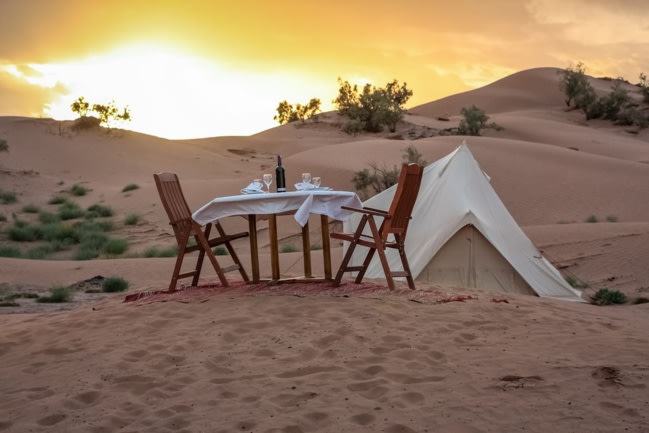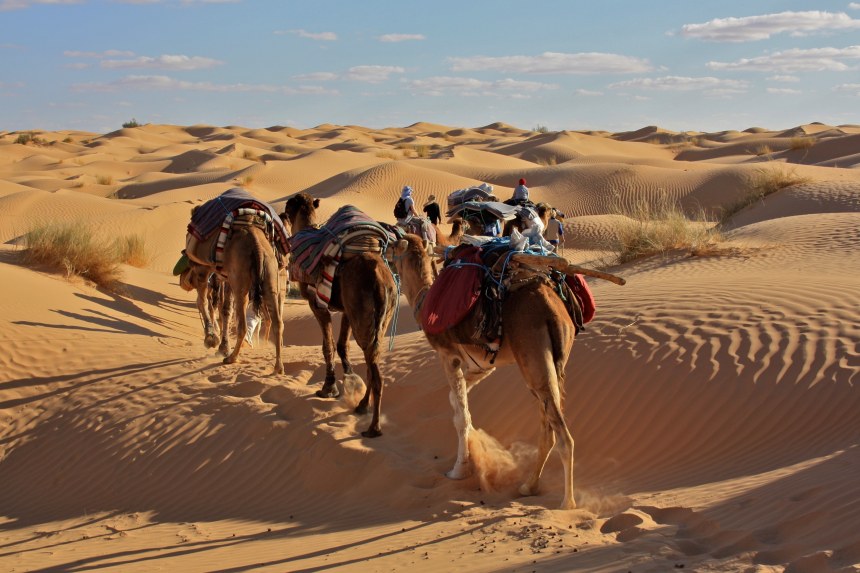
Morocco is a multifaceted country with exciting cities, wonderful coast, the Atlas Mountains and last, but certainly not least, the Sahara Desert. As big as the USA, this desert stretches from the Red Sea in the east and the Mediterranean in the north all the way to Morocco and the Atlantic Ocean on Africa’s western shore. Most of the Sahara is comprised of rocky stone plateaus, but in Morocco, it becomes the archetypal desert of popular imagining, ditching the rocks for a rippling coat of towering dunes, which constantly change shape and colour, from brilliant orange to rosy pink.
Travelling to the Sahara demands a road journey of several hours, but the scenery along the way entertains as you draw ever closer to the desert. Hop out and explore remote kasbahs and valleys lush with date palms, fields where goats nibble wildflowers and orchards of hazel and almond trees. Once in the Moroccan Sahara, you’ll find small oases fringed with date palms nestling amid the dunes, and a handful of hardy Berber people here, too, carving out a slow-paced, low-impact life that has barely changed in the countries.
Where to go in the desert?
Morocco has two major Saharan dune systems or ergs, as these vast seas of shifting, windswept crests and valleys are correctly called. Erg Chebbi is located at the end of a sealed road near Merzouga, just 20km from the Algerian border. It stretches 50km from north to south, with iconic dunes that tower up to 150m high. Erg Chegaga, 50km west of M’Hamid, is less easy to access than Erg Chebbi – you’ll need a camel or 4x4 to get amongst it – but many feel taking time to travel here is worth the effort for the silence and undiluted drama.
Few trips run into the disputed Western Sahara region of Morocco in the south, but it is possible to visit on an organised tour, although this will take you well off the tourist trail and away from any major cities. This is a wild, arid land of Saharawi nomads, rolling dunes and camel trains, strong traditions and awe-inspiring scenery.
Getting to the Moroccan Sahara
Direct flights to Morocco are easy to come by, especially from Europe, but if you want to visit the Moroccan Sahara, be prepared for long road journeys and for its vastness once here. Trips that take in the Erg Chebbi dune field head for Merzouga, pausing in frontier towns like Erfoud and Rissani. For an idea of journey times, from Midelt in the north to Merzouga takes about five hours. Trips bound for Erg Chegaga tend to go from Ouarzazate, along the lush Draa Valley to Zagora and finally to M’Hamid, at the end of the road and the start of the desert – a distance of 260km. The distances, remoteness and, often, the need for a 4x4 mean that joining a small group or tailor-made trip is the easiest way to visit the Moroccan Sahara. In addition, an organised tour will arrange for a night or two camping in the desert, with a cook and crew to set up camp and usually contacts among the local Berber community. Here, you will have the chance to learn about their lives around the campfire after admiring the sparkling night sky and enjoying a hearty dinner.
Few people come just for the desert, though. Instead, multi-layered and diverse Morocco offers a host of other attractions, from coast to city and mountains. A week is enough to see Marrakech; take a short trek in the High Atlas, then follow the N9 road down to M’Hamid for the desert dunes of Erg Chegaga. Or take two weeks and loop round from Casablanca to the capital, taking in old town medinas, marvellous mountains and the wide-open desert, too. Road transport tends to be the main means of getting around, although some itineraries use trains for a few sections.



